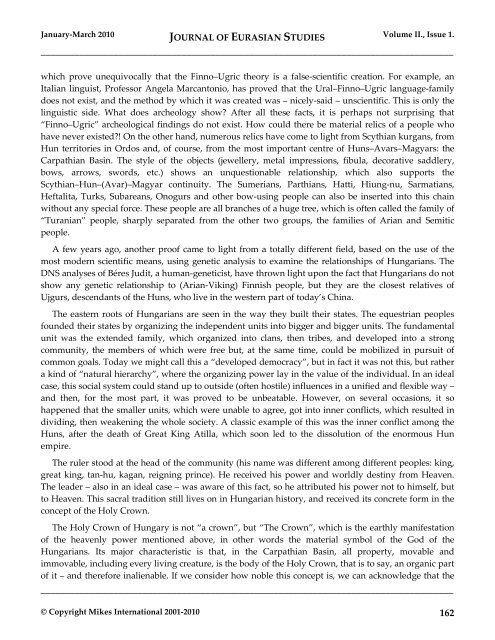EurasianStudies_0110..
EurasianStudies_0110..
EurasianStudies_0110..
You also want an ePaper? Increase the reach of your titles
YUMPU automatically turns print PDFs into web optimized ePapers that Google loves.
January-March 2010 JOURNAL OF EURASIAN STUDIES Volume II., Issue 1.<br />
_____________________________________________________________________________________<br />
which prove unequivocally that the Finno–Ugric theory is a false-scientific creation. For example, an<br />
Italian linguist, Professor Angela Marcantonio, has proved that the Ural–Finno–Ugric language-family<br />
does not exist, and the method by which it was created was – nicely-said – unscientific. This is only the<br />
linguistic side. What does archeology show? After all these facts, it is perhaps not surprising that<br />
“Finno–Ugric” archeological findings do not exist. How could there be material relics of a people who<br />
have never existed?! On the other hand, numerous relics have come to light from Scythian kurgans, from<br />
Hun territories in Ordos and, of course, from the most important centre of Huns–Avars–Magyars: the<br />
Carpathian Basin. The style of the objects (jewellery, metal impressions, fibula, decorative saddlery,<br />
bows, arrows, swords, etc.) shows an unquestionable relationship, which also supports the<br />
Scythian–Hun–(Avar)–Magyar continuity. The Sumerians, Parthians, Hatti, Hiung-nu, Sarmatians,<br />
Heftalita, Turks, Subareans, Onogurs and other bow-using people can also be inserted into this chain<br />
without any special force. These people are all branches of a huge tree, which is often called the family of<br />
“Turanian” people, sharply separated from the other two groups, the families of Arian and Semitic<br />
people.<br />
A few years ago, another proof came to light from a totally different field, based on the use of the<br />
most modern scientific means, using genetic analysis to examine the relationships of Hungarians. The<br />
DNS analyses of Béres Judit, a human-geneticist, have thrown light upon the fact that Hungarians do not<br />
show any genetic relationship to (Arian-Viking) Finnish people, but they are the closest relatives of<br />
Ujgurs, descendants of the Huns, who live in the western part of today’s China.<br />
The eastern roots of Hungarians are seen in the way they built their states. The equestrian peoples<br />
founded their states by organizing the independent units into bigger and bigger units. The fundamental<br />
unit was the extended family, which organized into clans, then tribes, and developed into a strong<br />
community, the members of which were free but, at the same time, could be mobilized in pursuit of<br />
common goals. Today we might call this a “developed democracy”, but in fact it was not this, but rather<br />
a kind of “natural hierarchy”, where the organizing power lay in the value of the individual. In an ideal<br />
case, this social system could stand up to outside (often hostile) influences in a unified and flexible way –<br />
and then, for the most part, it was proved to be unbeatable. However, on several occasions, it so<br />
happened that the smaller units, which were unable to agree, got into inner conflicts, which resulted in<br />
dividing, then weakening the whole society. A classic example of this was the inner conflict among the<br />
Huns, after the death of Great King Atilla, which soon led to the dissolution of the enormous Hun<br />
empire.<br />
The ruler stood at the head of the community (his name was different among different peoples: king,<br />
great king, tan-hu, kagan, reigning prince). He received his power and worldly destiny from Heaven.<br />
The leader – also in an ideal case – was aware of this fact, so he attributed his power not to himself, but<br />
to Heaven. This sacral tradition still lives on in Hungarian history, and received its concrete form in the<br />
concept of the Holy Crown.<br />
The Holy Crown of Hungary is not “a crown”, but “The Crown”, which is the earthly manifestation<br />
of the heavenly power mentioned above, in other words the material symbol of the God of the<br />
Hungarians. Its major characteristic is that, in the Carpathian Basin, all property, movable and<br />
immovable, including every living creature, is the body of the Holy Crown, that is to say, an organic part<br />
of it – and therefore inalienable. If we consider how noble this concept is, we can acknowledge that the<br />
_____________________________________________________________________________________<br />
© Copyright Mikes International 2001-2010 162

















